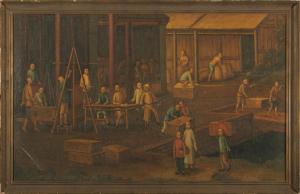The way we call tea in different regions of the world is influenced by the different pronunciations of the word ‘tea’ in Chinese as well as the power balance of different regions throughout history.
3 Ways Of Pronouncing Tea
China has many ethnic groups and thus they have their own pronunciations of the word tea.
- North China: ‘Cha’
- South China: ‘Tey’ or ‘Ti’
- Southwest China: ‘La’
6th Century: The Beginning Of Tea Exchange
Starting from the 6th Century, China started exporting tea during the Sui Dynasty. The North was the most influential region with many export activities focused on shipping tea to Japan, Turkey, Russia, Iran, Portugal and other Arabic countries. Therefore, these countries way of pronouncing tea is very similar to ‘cha’. Try to translate the word tea from English to any language from the mentioned countries, and you will find that they use ‘cha’ or variations such as ‘chai’ or ‘char’. For example:
- Russia: char
- Japanese: cha
- Turkish: çay

16th & 17th Century: Tea Export To Europe
During this period, economic activity shifted from the North to the Southern part of China where tea was at that time pronounced as ‘Tey’. Main export destinations in Europe with the most demand coming from Britain, France, Holland, Germany, Italy, and Spain. These countries therefore use pronunciations close to ‘tey’ or ‘ti’.
- France: thé
- Holland: thee
- Germany: tee
- Italy: tè
- Spain: té
- Britain: tea

What’s particularly interesting is that even though Portugal and Spain are neighboring countries with a very closely related language, they pronounce tea differently (Portugal: chá, Spain:té). This proofs the importance of dominance of tea producing regions in China over different periods of time through history.
Exceptions
Some European countries such as Poland are an exception. In Polish the word for tea isn’t related to either of the pronunciations mentioned above, but comes from the word ‘herb’: herbata.
Export to Countries Neighboring China
At the same time the Dai, Miao, and Yi minorities in the Southwestern part of China also started exporting tea to neighbouring countries, such as Laos, Burma, Cambodia. As these ethnic minorities pronounce tea as ‘la’ the importing countries are using the same term in their languages.
Discover more from Hello Tea Cup
Subscribe to get the latest posts sent to your email.


No Comments